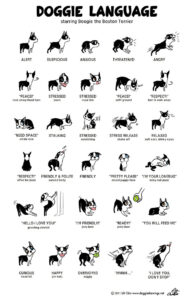Dogs have a fascinating way of communicating, primarily through their body language. Picture a dog’s body as a puzzle, with three key pieces: the face, the body, and the tail. The beauty of this canine communication is that it varies depending on the breed, shape, and size of the dog, resulting in subtle differences. Below, we’ll provide you with a general guideline to decipher your furry friend’s body language, with the understanding that each dog is unique.
Reading a Dog’s Face
Interpreting a dog’s facial expressions can be challenging, especially considering differences in breed and modifications like cropped ears or naturally stiff ears. Nevertheless, there are some reliable indicators to consider:
Ears: The positioning and movement of a dog’s ears can reveal a lot about their emotional state. Here’s what to look for:
- Forward: Ears perked up or angled forward indicate attentiveness and a high alert level.
- Down/Relaxed: When a dog’s ears are in a neutral position, it means they are calm and not overly concerned about their surroundings.
- Back: Ears pulled all the way back suggest wariness, potential concern, or a heightened defensive state.
- Twitch: If the dog’s ears are twitching while you’re speaking, it signifies that they hear you but are more focused on something else.
Eyes: Dogs are incredibly expressive through their eyes, but it’s essential to remember that some breeds naturally have different eye shapes and widths. Here are some significant stress indicators conveyed through a dog’s eyes:
- Stare Down: When a dog maintains unbroken eye contact, it signifies intense focus. However, additional body signs must be considered to understand their behavior fully.
- Glancing/Scanning: Dogs that constantly scan the room from side to side or glance out of the corners of their eyes often do so out of fear.
- Whale Eye: If a dog’s pupils are dilated, and the whites of their eyes are showing, it’s a clear indicator of fear.
Mouth: Beyond vocalization, dogs use their mouths to communicate subtly yet effectively. Here’s what you should know:
- Heavy Panting: While heavy panting can indicate overheating, it often signifies intense stress.
- Yawning: Dogs yawn not only when tired but also as a de-escalation behavior, signaling, “Don’t look at me; I’m not a threat.”
- Back Teeth Snarl: This defensive warning indicates discomfort and the desire for personal space.
- Front Teeth Snarl: This “offensive” warning suggests a forward move or threat.
Understanding Body Language
Identifying a dog’s body posture, hackles, and tension can offer early warnings about their mood, whether they’re excited, potentially problematic, or overwhelmed. Here’s what to look for:
Posture: A dog’s body posture serves as a thermometer for their focus and emotional state. Consider these postures:
- Play Bow: This posture signals playfulness and excitement.
- Laying Down: It’s essential to differentiate between a dog curling up in fear and one in a relaxed, comfortable state.
- Resting on Hip: A dog resting on its hip usually indicates relaxation in the current situation.
- Side Standing: This posture suggests a nervous dog that may be unsure or confident, depending on the context.
Hackles (Piloerection): While not all breeds can raise their fur, some can raise it from the top of their heads to their tails. Here’s what to understand:
- Raised Fur: Elevated fur can indicate peak energy, whether positive or negative. Assess the environment and other body cues for an accurate interpretation.
- Tension: Similar to posture, tension is a gauge of energy buildup or reduction before an action.
- Stiffness: A stiff body often reflects fear or fixation on a specific stimulus, making their movements awkward.
- Relaxation: A relaxed dog moves with fluidity, whether playing, sleeping, or merely moving around.
Decoding the Tail’s Language
Tails provide another essential aspect of canine communication. However, reading tails can be tricky due to variations in size, fur length, and the presence or absence of a tail. Here’s what to consider:
Tail Position: There are three primary tail positions to evaluate in tail communication. Keep in mind that a long, fluffy tail and a short nub can convey the same position, though it may be less visible with a shorter tail:
- High: A high tail position typically signals excitement and high energy.
- Mid: A tail held mid-range indicates a neutral, calm disposition, with the dog open to interactions and situations as long as there’s some movement.
- Low: A low tail often suggests discomfort, uncertainty, or fear of the surroundings. While not necessarily negative or indicative of sadness, it’s a position to be mindful of.
Tail Speed: The speed of a tail’s movement is another crucial factor in understanding a dog’s communication:
- Fast: A wagging tail does not necessarily denote happiness but rather stimulation. A fast, tense tail reflects peak emotions like fear or excitement, while a fast, relaxed tail suggests high emotions such as happiness or an invitation to play.
- Slow: A tail that is not moving or moves slowly can indicate a dog in high stress or a calm state. Positioning and tension should be considered to interpret the dog’s message accurately.
Tension/Fluidity: The overall tension or fluidity of a tail’s movement provides valuable insights into a dog’s emotional state:
- Rigid or Tense: A rigid or tense tail often indicates fear or over-excitement, although certain breed traits may cause exceptions. For example, bully breeds or Australian Shepherds with docked tails may exhibit rigidity due to breeding.
- Fluid or Relaxed: A relaxed tail wag is more fluid and wavy, forming an “S” shape. This signals that the dog is comfortable and confident in its surroundings.
In summary, understanding your dog’s body language is an invaluable skill that strengthens your bond and ensures a happy, harmonious relationship. While these guidelines offer a solid foundation, remember that each dog is unique, and variations may exist due to breed traits or individual personality. By becoming fluent in your furry friend’s body language, you’ll enhance your ability to communicate effectively and ensure your dog feels understood and cherished in your care.


